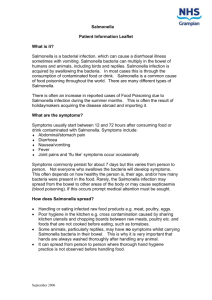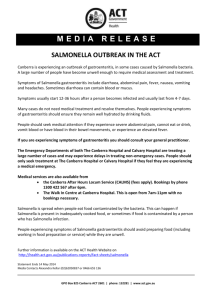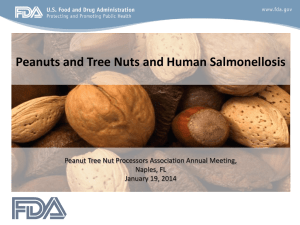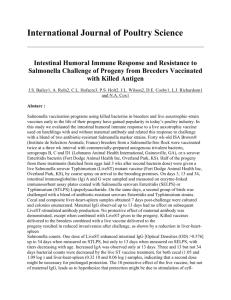Salmonella
advertisement
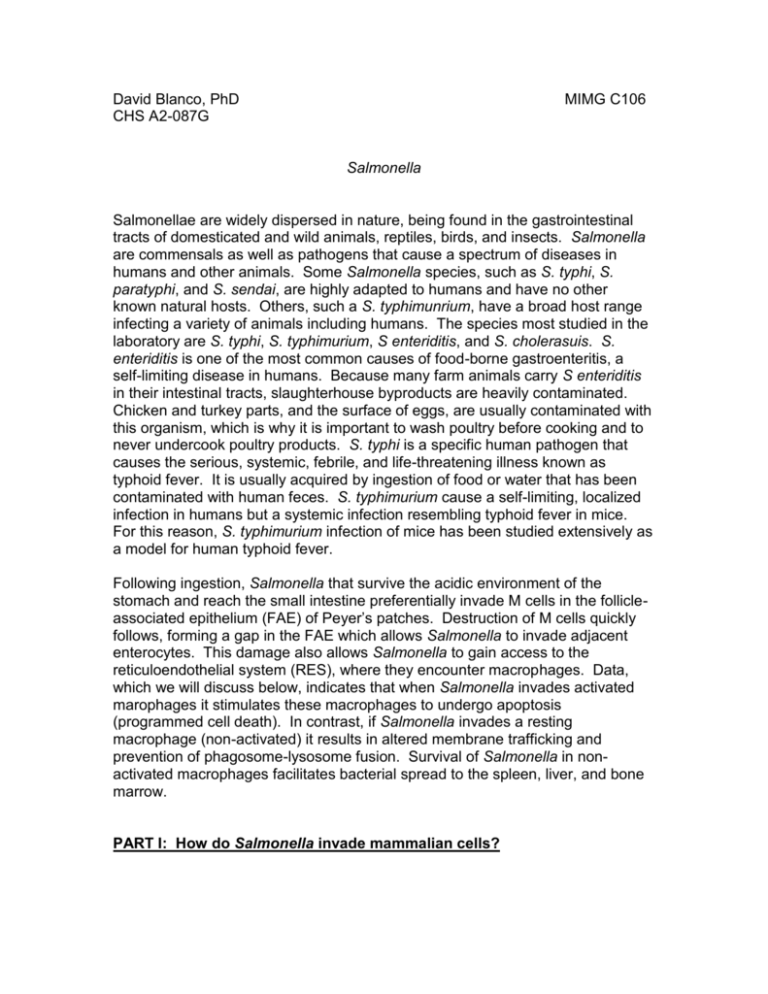
David Blanco, PhD CHS A2-087G MIMG C106 Salmonella Salmonellae are widely dispersed in nature, being found in the gastrointestinal tracts of domesticated and wild animals, reptiles, birds, and insects. Salmonella are commensals as well as pathogens that cause a spectrum of diseases in humans and other animals. Some Salmonella species, such as S. typhi, S. paratyphi, and S. sendai, are highly adapted to humans and have no other known natural hosts. Others, such a S. typhimunrium, have a broad host range infecting a variety of animals including humans. The species most studied in the laboratory are S. typhi, S. typhimurium, S enteriditis, and S. cholerasuis. S. enteriditis is one of the most common causes of food-borne gastroenteritis, a self-limiting disease in humans. Because many farm animals carry S enteriditis in their intestinal tracts, slaughterhouse byproducts are heavily contaminated. Chicken and turkey parts, and the surface of eggs, are usually contaminated with this organism, which is why it is important to wash poultry before cooking and to never undercook poultry products. S. typhi is a specific human pathogen that causes the serious, systemic, febrile, and life-threatening illness known as typhoid fever. It is usually acquired by ingestion of food or water that has been contaminated with human feces. S. typhimurium cause a self-limiting, localized infection in humans but a systemic infection resembling typhoid fever in mice. For this reason, S. typhimurium infection of mice has been studied extensively as a model for human typhoid fever. Following ingestion, Salmonella that survive the acidic environment of the stomach and reach the small intestine preferentially invade M cells in the follicleassociated epithelium (FAE) of Peyer’s patches. Destruction of M cells quickly follows, forming a gap in the FAE which allows Salmonella to invade adjacent enterocytes. This damage also allows Salmonella to gain access to the reticuloendothelial system (RES), where they encounter macrophages. Data, which we will discuss below, indicates that when Salmonella invades activated marophages it stimulates these macrophages to undergo apoptosis (programmed cell death). In contrast, if Salmonella invades a resting macrophage (non-activated) it results in altered membrane trafficking and prevention of phagosome-lysosome fusion. Survival of Salmonella in nonactivated macrophages facilitates bacterial spread to the spleen, liver, and bone marrow. PART I: How do Salmonella invade mammalian cells? Invasion of polarized Madin-Darby Canine Kidney (MDCK) cells by Salmonella has been used as an in vitro model to study the molecular mechanisms involved in invasion. MDCK cells can be grown as a polarized monolayer where the cells are joined by “tight junctions” and the apical surface displays microvilli, like epithelial cells lining the G.I. track. When Salmonella are added to monolayers of MDCK cells, the surface of the MDCK cells changes shape within 15 minutes, and hair-like appendages, called invasomes, form. Within the next 15 minutes, the invasomes disappear, and the MDCK cells change their morphology in the region just beneath the bacteria: large cup-like membrane ruffles form, enveloping the bacteria which are then internalized. Once inside, the bacteria multiply within endosomes and eventually are released from the basolateral surface of the MDCK cells. This remarkable process requires genes within the Salmonella inv locus: Stains with mutations in invG or invC never form invasomes and do not become internalized; strains with mutations in invA or invE form invasomes but never retract them and never become internalized. How do the inv genes relate to invasomes and to invasion? The inv locus is part of a 35 kb stretch of DNA at centisome 63 on the Salmonella chromosome. Many additional loci required for invasion are also located here. This region constitutes a pathogenicity island, called SPI1 (Salmonella pathogenicity island 1). Several features of pathogenicity islands support the model that they represent mobile genetic elements that confer pathogenicity phenotypes: Carry (often many) virulence related genes. Presence in pathogenic strains, absence or sporadic distribution in lesspathogenic strains of the same species. Different G+C content compared to the rest of the chromosome. Occupy large chromosomal regions (>30 kb). Represent distinct genetic units. Associated with tRNA genes and/or IS elements at boundaries. Presence of (often cryptic) “mobility” genes. Instability. The Enteropathogenic Escherichia coli (EPEC) locus of enterocyte effacement (LEE) is an example of how virulence phenotypes can be gained and lost by acquisition of pathogenicity islands. Enteropathogenic E. coli (EPEC) is a potentially fatal diarrhoeal pathogen that strikes infants in developing countries. EPEC causes attaching and effacing lesions when it interacts with intestinal epithelial cells – basically, microvilli are replace by compact microfilamentous structures that look like pedestals beneath the bacteria. Coincident with pedestal formation is the induction of host signal transduction cascades that lead ultimately to diarrhea. Many genes required for EPEC virulence were found to map to the LEE pathogenicity island. To test the hypothesis that the LEE is a function cassette, sufficient to confer upon non-pathogenic E. coli the ability to induce AE lesions, McDaniel and Kaper (1997, Molecular Microbiology, 23:399-407): Cloned the LEE locus into a plasmid. Introduced this plasmid into several non-pathogenic lab strains of E. coli such as DH5α and HB101. Showed that DH5α and HB101 carrying the LEE-containing plasmid, but not the plasmid vector alone, secreted a protein, EspB, that was previously shown to be required for virulence. Showed that DH5α and HB101 carrying the LEE-containing plasmid, but not the plasmid vector alone, induced tyrosine phosphorylation of a protein, HP-90, present in the host cell plasma membrane – a phenotype previously shown to be associated with AE lesion formation. Showed microscopically that DH5α and HB101 carrying the LEEcontaining plasmid, but not the plasmid vector alone, could induce the formation of AE lesions in CaCo-2 cells. These experiments provide strong evidence that specific aspects of pathogenicity can be acquired by horizontal gene transfer of genetic elements such as pathogenicity islands. How do the Salmonella inv genes mediate invasion? Many of the gene products encoded within the Salmonella SPI1 were found to be similar to gene products that form type III or contact-dependent secretion systems in Yersinia and Shigella. Since these genes appear to encode a type III secretion system, are required for invasion, and are required for the formation of invasomes, Jorge Galan’s group hypothesized that the invasome surface appendages are the salmonella type III secretion apparatus. To test this hypothesis, they isolated a supramolecular structure from the membranes of Salmonella typhimurium that appear to be at least part of the secretion apparatus (Kubori et al, 1998 Science, 280:602). They started with an flhC mutant of Salmonella. flhC is part of the master regulatory locus controlling motility in Salmonella. Since proteins that form the basal body of flagella are similar to components of type III secretion systems, it was important to use a strain that could not produce flagella. They osmotically shocked this strain and looked at the cytoplasmic and outer membranes by trasmission electron microscopy (TEM). What was observed were complex structures, which they called needle complexes, that spanned the cytoplasmic and outer membranes and extended outward from the cell surface. They then isolated these needle complexes by CsCl density centrifugation. The needle complexes were present in the flhC mutant, but not in strains that also contained mutations in invG, prgH, or prgK. They next separated the proteins in the purified needle complexes by SDS-PAGE and stained them by silver stain. Proteins of 62-, 52-, and 31kDa were prominent. These are the predicted M.W. protein sizes (based upon the deduced amino acid sequence derived from the gene sequence) of InvG, PrgH, and PrgK. They next constructed a strain expressing an epitope-tagged PrgH. The epitope they used, called M45, could be detected by a specific monoclonal antibody (anti-M45 MAb). The strain expressing the epitope tagged PrgH could secrete proteins normally secreted by wild type Salmonella, indicating that the epitope-tagged PrgH could form a functional secretion apparatus. Needle complexes purified from the epitope-tagged PrgH expressing strain were then incubated with anti-M45 MAb and visualized by immunoelectron microscopy. Antibody molecules could be seen around the basal structure as detected by an anti-mouse antibody conjugated to the electron dense material colloidal gold. These data suggest that the needle complexes are in fact the type III secretion apparatus encoded by SPI1 and that they form the invasomes that mediate entry into host cells. What is the host cell contribution to Salmonella type III secretion mediated invasion? Interaction of Salmonella with eukaryotic cells induces profound rearrangement of the eukaryotic cell cytoskeleton, the formation of membrane ruffles, and subsequent internalization of the bacteria. The induction of membrane ruffles is critical for entry of Salmonella: mutants unable to induce ruffles do not invade. The appearance of membrane ruffles is accompanied by profound cytoskeletal rearrangements at the point of the bacterial-host cell contact and several cytoskeletal proteins, including actin, αactin, talin, tubulin, tropomyosin, and ezrin accumulate at these sites. Salmonella infection of cultured cells is accompanied by a marked increase in intracellular Ca2+ concentration: i) Ca2+ chelators and antagonist of Ca2+ channels block entry of Salmonella and ii) mutants that are unable to invade do not induce increases in intracellular Ca 2+ concentration. Several actin-bundling proteins, such as gelsolin, villin, and plastin, can become actin-serving proteins in response to increased intracellular Ca2+ concentration. Membrane ruffling, cytoskeletal rearrangements, and Ca2+ fluxes have been observed as a consequence of the activation of a number of host cell surface receptors, including the epidermal growth factor receptor (EGFR). Galan’s group has shown that infection of Henle-407 cells by Salmonella is accompanied by activation of the EGFR. Model for how bacterial attachment leads to internalization: Attachment of Salmonella to the mammalian cell surface stimulates a receptor (possibly the EGFR; epithelial growth factor receptor) that initiates a signaling cascade resulting in the activation of MAP-kinase, a central regulatory molecule. MAP-kinase activates phopholipase A2 (PLA2). Arachidonic acid (AA) is produced and converted to leukotriene D4 (LTD4). LTD4 activates a calcium channel allowing the influx of Ca2+. Increased [Ca2+] causes depolymerization of actin microfilaments that in turn cause membrane blebs. Release of profiling from the membrane can also participate in cytoskeletal reorganization. Supporting evidence for this model: In Henle-407 cells, Salmonella infection results in stimulation of the EGFR. invA mutants DO NOT stimulate the EGFR and DO NOT invade. invA mutants +EGF result in stimulation of the EGFR and invasion of the Salmonella. E. coli (a nonpathogenic lab strain) +EGF results in stimulation of the EGFR and internalization of the E. coli. Inhibition of PLA2 or 5-LO prevents invasion. Contact of Salmonella with Henle-407 cells results in increased LTD4 levels and increased [Ca2+]. Inv mutants + LTD4 cause increased [Ca2+] and invasion. Chelation of extracellular Ca2+ or addition of Ca2+ channel antagonists causes decreased ruffling and decreased invasion. PART II: Interaction of Salmonella with macrophages Salmonella induced apoptosis in (activated macrophages). Salmonella are able to survive within macrophages and this ability has been shown by several laboratories to be an important aspect of Salmonella pathogenesis. In 1996 and 1997, however, four separate groups reported that the interaction between Salmonella and macrophages in vitro sometimes results in cytotoxicity and death of the macrophages. For example, Chen et al. (1996, Molec. Microbiol. 21:1101) incubated wild type Salmonella typhimurium with J774A.1 cells, a mouse macrophage-like cell line routinely used for in vitro studies, and observed the interaction over time using video microscopy. Within 2 to 15 minutes, increased membrane ruffling and macropinocytosis in the macrophages was seen. From 15 to 30 minutes postinoculation, the ruffling and macropinocytosis decreased and after 30 minutes, the J774A.1 cells began rounding up and lifting off the bottom of the tissue culture wells. When macrophage cell death was quantitated by microscopic examination of cells stained with the membrane-impermeant dye eithidium homodimer-1, it was found that the percentage of dead cells increased from about 20% at 20 minutes to about 80% at 8 hours post-inoculation. Is the SPI1-encoded type III secretion system required for cytotoxicity? To determine if the SPI1 encoded type III secretion system is involved in the induction of macrophage cytotoxicity, Chen et al. compared cytotoxicity induced by wild type Salmonella with that induced by strains with mutations in various SPI1 loci. All mutants that were unable to invade tissue culture cells were also unable to induce cytotoxicity in J774A.1 cells, while mutants that were not defective for internalization induced cytotoxicity just like wild type Salmonella. Therefore, type III secretion-dependent internalization of Salmonella coincided with cytotoxicity. Salmonella-induced cytotoxicity exhibits features of apoptosis (programmed cell death). Apoptosis – or programmed cell death – is the result of a highly regulated process that is controlled by complex signal transduction pathways. In contrast to necrotic death, such as when cells die from damage or poisoning and spill their contents over neighboring cell eliciting an inflammatory response, in apoptotic death the cell nucleus becomes condensed, the cell shrivel, and the shrunken corpse is rapidly engulfed and digested by neighboring cells. Apoptosis is an intrinsic part of embryogenesis, tissue turnover, immunological killing mechanisms, and also of mechanisms of tumor growth and regression, and apoptosis does not result in a host inflammatory reaction. Chen et al. used three approaches to determine if macrophage cytotoxicity induced by Salmonella occurred via apoptosis: 1. J774A.1 cells incubated with wild type Salmonella were stained with DAPI, which stains DNA, and examined microscopically. Condensed and fragmented chromatin, consistent with apoptotic death was observed. 2. J774A.1 cells incubated with wild type Salmonella were examined by transmission electron microscopy: membrane blebbing, chromatin condensation, and the presence of apoptotic bodies were seen. 3. Fragmented DNA in J774A.1 cell incubated with wild type Salmonella was detected using a fluorescent TUNEL assay (TUNEL = terminal deoxyribonucleotidyl transferase-mediated dUTP-digoxigenin nick end labeling). The nuclei of J774A.1 cells infected with wild type Salmonella stained positively in this assay. Taken together, these data suggests Salmonella-induced death of J774A.1 cells occurs by apoptosis. Is bacterial internalization required for induction of apoptosis? Salmonella strains with mutations in genes required for internalization did not induce cytotoxicity while stains with mutations in SPI1 genes that were not required for internalization did induce cytotoxicity. These results suggest that internalization of Salmonella may be required for induction of cytotoxicity/apoptosis. To test this hypothesis, Chen et al. incubated J774A.1 macrophages with Salmonella in the presence and absence of cytochalasin D. Cytochalasin D disrupts the actin cytoskeleton preventing phagocytosis. In the presensce of cytochalasin D therefore, Salmonella will adhere to the J774A.1 cells but will not be internalized. Chen et al. found that Salmonella induced cytotoxicity in both the presence and absence of cytochalasin D (unlike Shigella, which caused cytotoxicity only in the absence of cytochalasin D), suggesting that Salmonella could trigger apoptosis from the cell surface. Since type III secretion systems have been shown to be able to secrete and translocate proteins directly into the cytoplasm, or plasma membranes of eukarytotic cells, this result suggests one or more proteins secreted by the SPI1 encoded type III system may be responsible for inducing apoptosis in host cells. Does the “activation state” of the macrophage influence the induction of apoptosis? Monack et al. (1996, PNAS 93:9833) measured apoptosis induced by wild type and several mutant strains of Salmonella in RAW264.7 macrophage-like cells and bone marrow derive macrophages (BMM). The Salmonella mutants fell into two classes: 1) those that could invade but could not replicate within phagosomes (inv+ rep-) and 2) those that could not induce membrane fuffling and could not invade, but could replicate in phagosomes (inv- rep+). Three questions were addressed: 1. Is replication within the phagosome required for induction of apoptosis? 2. Is invasion required for induction of apoptosis? 3. Does the source (possibly reflecting the activation state) of the macrophage influence the ability of Salmonella to induce apoptosis? The ability of the [inv+ rep-] mutants to induce apoptosis in both RAW264.7 and BMM macrophages was the same as wild type Salmonella, indicating the ability to replicate within phagosomes is NOT required for induction of apoptosis. [invrep+] mutants were unable to induce significant apoptosis in either type of macrophage, suggesting invasion, or at least the ability to induce membrane ruffles, is required to induce apoptosis. Wild type Salmonella (and the inv+ repmutants) induced significantly more apoptosis in BMM than RAW264.7 cells, suggesting that the “activation state” of the macrophage, which is probably greater in BMM than in the RAW264.7 macrophage-like cell line, may influence the ability of Salmonella to induce apoptosis. As mentioned earlier, Salmonella does not always induce apoptosis in macrophages. In fact, the ability of Salmonella to survive within macrophages was recognized as an important aspect of Salmonella pathogenesis long before its ability to induce apoptosis was discovered. One theory is that Salmonella either enter and survive within macrophages or induce apoptosis depending on the activation state of the macrophage. Salmonella may induce apoptosis in activated macrophages to avoid from being killed themselves, i.e. kill or be killed. In contrast, Salmonella may opt to invade and survive in resting macrophages so that they can be transported to the liver, spleen, and bone marrow. How are Salmonella able to survive within macrophages? Expression of many virulence genes in Salmonella is controlled, at least in part, by a two-component signal transduction system called PhoP/PhoQ. PhoQ is a cytoplasmic membrane sensor molecule that responds to Mg2+ and Ca2+. In the relative absence of Mg2+ and Ca2+, PhoQ is active, autophosphorylates at a conserved histidine residue in its cytoplasmically located transmitter domain, and transfers this phosphoryl group to PhoP. PhoP is a cytoplasmic response regulator molecule that activates and/or represses gene transcription when active. PhoP/PhoQ control the expression of two classes of genes: prg (Phorepressed genes) loci and pag (Pho-activated genes) loci. When PhoP/PhoQ is inactive, in the presence of millimolar concentrations of Mg2+ or Ca2+, pag loci are not expressed and prg loci are expressed. Prg loci include components of the SPI1 encoded type III secretion system. The functions of pag loci are mostly unknown. To determine if either pag loci, prg loci, or both, are required for virulence, strains that are either rendered PhoP/PhoQ inactive (PhoP- or PhoQ-) or constitutively active (PhoPc) were constructed and compared with wild type Salmonella for their ability to cause a lethal infection of mice following i.p. injection. Less than 20 wild type Salmonella are required to kill a mouse when administered by this route. In contrast, the LD50s for PhoP-, PhoQ-, and PhoPc strains were about 105 (a 4 log increase in LD50). This result indicates that both pag and prg loci are required to virulence. One particular pag gene knockout mutation, pagC, was shown to also have an increased LD50. To determine if pag loci, prg loci, or both, are required for the bacterial to survive within macrophages, the “macrophage survival indexes” (MSI) for each of the same strains were determined. MSI = the mean bacterial count at 24 hours postinoculation of macrophages / the mean bacterial count a 1 hour post-inoculation. >1 = multiplication of the bacteria within the macrophages, <1 = death of the bacteria. Data are on a log scale. The MSI for wild type Salmonella was 6.13, indicating their ability to survive in the macrophages. The MSI for all of the mutants tested were <1, indicating that both pag and prg loci are required for survival of Salmonella. How can both pag loci AND prg loci be required? Clues came from looking at the course of events that occur following internalization. Pag gene expression is induced within macrophages, but not within epithelial cells. Sam Miller’s group (1992 PNAS 89:10079) constructed strains with lacZY fusions to pag loci, or to a non-PhoP/PhoQ regulated gene (ibg) as a control. They incubated macrophages with these strains then measured β-galactosidase activity at 1, 4, and 6 hours post-internalization. For pag-lacZY containing strains, β-galactosidase activity increased over time, while for the ibg-lacZY containing strain, β-galactosidase activity remained constant. In CaCo-2 cells, an epithelial cell line, β-galactosidase activity did not increase after internalization. Macrophages are equipped with several different mechanisms to destroy microorganisms within phagosomes, including toxic oxygen derivatives, reactive nitrogen intermediates, nutrient limitation, acidification of the compartment, and fusion of phagosomes with lysosomes that are rich in degradative enzymes. The observation that pag gene expression increased at 4 and 6 hours postinternalization suggested a coincident change in the phagosome environment. To test the possibility that pag gene expression increased in response to a drop in pH, strains containing pag-lacZY fusions were grown in buffered L broth at different pHs and β-galactosidase activity was measured. Pag-lacZ expression was higher in cells grown at pH < 4.7 compared to cells that were grown at pH 5.0, indicating that pag gene expression is indeed regulated by pH. To determine if the pag gene expression at 4 and 6 hours post-internalization in macrophages was coincident with, and dependent on, acidifcation of the phagosome, NH4Cl or chloroquine was added to the tissue culture medium. These compounds prevent adicification of the phagosome. In the presence of these compounds, pag-lacZ expression did NOT increase following internalization. These data suggest that PhoP/PhoQ becomes active within the phagocytic vesicle and that this activation coincides with a drop in pH. (Remember, however, that in vitro, PhoP/PhoQ responds to Mg2+ and Ca2+. The true signals sensed in nature by PhoP/PhoQ have not yet been definitively proven. The change in pH within phagosomes could be coincidental). Salmonella alters acidification of the phagosome. Phagocytic vesicles containing yeast particles or latex beads have been shown to become acidified within about 2 hours after phagocytosis. In the above experiment, pag gene expression did not increase until about 4 hours postinternalization. To determine if Salmonella actively influenced phagosome acidification, the pH of phagosomes was measured after internalization of either live or heat killed Salmonella. Phagosome pH was measured using FITCdextran. The fluorescence spectrum of fluorescein varies as a function of pH. This was measured in individual phagosomes by quantitative fluorescence microscopy. When heat-killed Salmonella were internalized, the pH of the phagosome dropped rapidly to < 4.4 within about 1 hour. In contrast, when live Salmonella were internalized, the pH of the phagosomes droped only to about 5 and only after 5 hours. So, live Salmonella apparently delayed and decreased the magnitude of phagosome acidification. Salmonella stimulate macrophage macropinocytosis. How does Salmonella survive inside the early phagosome long enough to allow delayed pag expression? (pag genes are required for survival within phagosomes but are not induced until 4 to 6 hours post-internalization). 1. Salmonella stimulate macropinocytosis and persist in spacious phagosomes. 2. PhoPc mutants were deficient in induction of spacious phagosomes. These results suggest that prg-encoded proteins are involved in stimulation of macropinocytosis and spacious phagosome formation. Salmonella stimulate phagosomes to diverge from degradative endocytic pathway. Phagosomes destined to traffic along the degradative pathway of the host cell’s endocytic network are thought to undergo a series of sequential biochemical modifications and vesicle fusion reactions. A number of markers specifc for unique compartments within the endocytic pathway have been used to characterize changes that occur during the process. As the phagosome matures, proteins which initially compose the newly formed compartment disappear and are replaced, first by proteins present in early endosomes, such as rab5, the transferring receptor, and low-density lipoproteins, and later by proteins inherent to late endosomes/relysomes, including rab7, rab9, mannose-6phosphate receptors (M6PRs), and lysosomal membrane glycoproteins (LAMPs). The function of M6PRs is to deliver a subset of newly synthesized, soluble, lysosomal enzymes from the trans-Golgi network to the prelysosomal compartments. The prelysosome is transformed into a degradative compartment through the further incorporation and/or processing of lysosomal hydrolases such as cathepsins, lysosomal acid phosphatases (LAP), and β-glucuronidase. So, M6PR serves as a marker for fusion of late endosomes (lysosome) with the phagosome, and markers delivered by M6PR-dependent mechanisms include cathepsin-L. LAMP and LAP, markers for late endosome and lysosome fusion, respectively, are delivered by M6PR-independent mechanisms. To determine if Salmonella alters the trafficking pattern of phagosomes within which it resides, Rathman et al. (1997, I&I 65:1475-1485) incubated macrophages with either latex beads, wild type Salmonella or an inv- Salmonella mutant for 30 minutes or 10 hours, stained with fluorescently labeled antibodies against M6PR, LAMP1, LAP, and cathepsin, and examined them using fluorescence microscopy. (Latex beads accumulated with all of these markers over time, indicating the noramal trafficking of these phagosomes down an endocytic pathway). By comparison, Salmonella containing phagosomes colocalized with LAMP1 and LAP, but not M6PR or cathepsin, suggesting these phagosomes had diverged from the endocytic pathway. Since co-localization of markers on phagosomes containing the inv- strain was similar to that of phagosomes containing wild type Salmonella, invasion via the SPI1 encoded type III secretion system is apparently not required for this phenotype. This suggests that regardless of whether Salmonella enter phagocytes by phagocytosis or bacterial (type III) mediated entry, they are able to alter the phagosome trafficking pattern. The ability to alter the trafficking patten was, however, dependent on the viability of the Salmonella, as phagosomes containing heat killed bacteria contained M6PR, LAMP1, LAP, and cathepsin-L, just like phagosomes containing latex beads. Resistance to defensins is a pag-encoded phenotype. Defensins are amphipathic, cationic, antimicrobial peptides (approx. 4-kDa in size) found within neutrophil granules, macrophage phagosomes, and secretions of mucosal epithelia. Defensins probably kill gram negative bacteria by binding to LPS through ionic bonds with the unsubstituted, negatively charged phosphoryl groups of lipid A. Salmonella grown under conditions in which PhoP/PhoQ is active are relatively resistant to a particular rabbit defensin called NP-1. PhoP- and PhoQ- strains are sensitive to NP-1 while PhoPc mutants are resistant to NP-1. Polymyxin B is a cationic antibiotic that kills bacteria by a mechanism similar to that of defensins. Polymyxin B resistance in Salmonella requires the pmrA locus. PmrAB was shown to be positively regulated by PhoP/PhoQ. To determine if Polymyxin B resistance is controlled by PhoP/PhoQ, wild type and mutant strains of Salmonella were compared for their ability to grow in the presence of different concentrations of Polymyxin B. PhoP-, PmrA-, or wild type Salmonella grown under conditions in which PhoP/PhoQ is inactive, were sensitive to low concentrations of Polymyxin B, while PhoPc strains and wild type Salmonella grown under conditions where PhoP/PhoQ is active were resistance to high concentrations of Polymyxin B, indicating that like resistance to defensins, similar resistance to Polymyxin B is pag-encoded.


